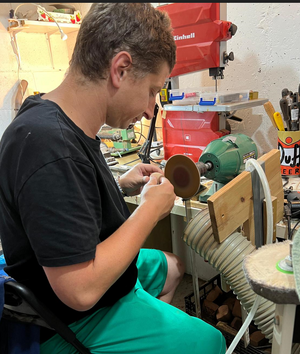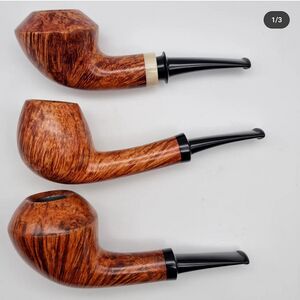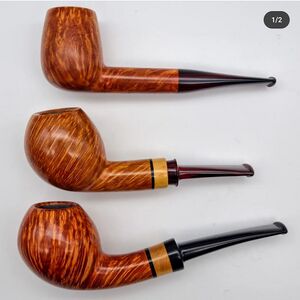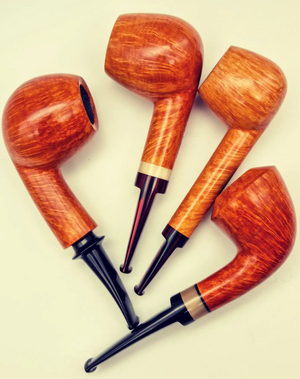Franz Pipes: Difference between revisions
mNo edit summary |
mNo edit summary |
||
| Line 2: | Line 2: | ||
Franz Pipes are made by Roberto Franzini (b. 1982). Franzini was born in Domodossola, a small city in the mountains of northwest Italy, but now lives with his family in Saronno, another northern Italian city in the hinterland of Milan. Franz is Franzini’s nickname, one that also belonged to his father, and to his grandfather, and is the name Franzini chose to give to his pipes. | Franz Pipes are made by Roberto Franzini (b. 1982). Franzini was born in Domodossola, a small city in the mountains of northwest Italy, but now lives with his family in Saronno, another northern Italian city in the hinterland of Milan. Franz is Franzini’s nickname, one that also belonged to his father, and to his grandfather, and is the name Franzini chose to give to his pipes. | ||
Franzini began making pipes in 2012, after hearing one of his colleagues mention that his dentist was an avid pipe smoker and a pipe maker. Driven by curiosity, Franzini turned to the internet to learn about pipe making from videos and other online resources. Soon after discovering the world of pipe making on the internet, Franzini bought his first briar blocks and tools, and began trying the craft for himself. Oddly enough the dentist that Franzini had heard about from his colleague was none other than the Milanese pipe maker [[Angelo Fassi]], with whom Franzini would later become good friends. The two continue to visit each other, smoke pipes, and discuss pipe making, to this day. | |||
Franzini began making pipes in 2012, after hearing one of his colleagues mention that his dentist was an avid pipe smoker and a pipe maker. Driven by curiosity, Franzini turned to the internet to learn about pipe making from videos and other online resources. Soon after discovering the world of pipe making on the internet, Franzini bought his first briar blocks and tools, and began trying the craft for himself. Oddly enough the dentist that Franzini had heard about from his colleague was none other than the Milanese pipe maker Angelo Fassi, with whom Franzini would later become good friends. The two continue to visit each other, smoke pipes, and discuss pipe making, to this day. | |||
Franzini was initially self-taught, just as many pipe makers are today. As he says himself, in the beginning,<blockquote>“I learned from myself: wrong, wrong, and again wrong.”</blockquote> | Franzini was initially self-taught, just as many pipe makers are today. As he says himself, in the beginning,<blockquote>“I learned from myself: wrong, wrong, and again wrong.”</blockquote> | ||
| Line 12: | Line 8: | ||
But, as with any pursuit, learning by trial and error – even when it seems as though there are more errors than trials – is nonetheless learning. In the words of Samuel Beckett, “Try again. Fail again. Fail better.” Franzini committed to his new craft and continued to use his early mistakes as a means of self-improvement. Living in northern Italy, a region historically renowned for pipe making, Franzini was also able to visit other artisans in their workshops and receive advice on various pipe making techniques. Attending events at the Savinelli and Brebbia factories further contributed to the development of his skills in working with briar. | But, as with any pursuit, learning by trial and error – even when it seems as though there are more errors than trials – is nonetheless learning. In the words of Samuel Beckett, “Try again. Fail again. Fail better.” Franzini committed to his new craft and continued to use his early mistakes as a means of self-improvement. Living in northern Italy, a region historically renowned for pipe making, Franzini was also able to visit other artisans in their workshops and receive advice on various pipe making techniques. Attending events at the Savinelli and Brebbia factories further contributed to the development of his skills in working with briar. | ||
[[File:Franzpipe2.jpg|thumb|A selection of Franz Pipes. Image courtesy Roberto Franzini.]] | [[File:Franzpipe2.jpg|thumb|A selection of Franz Pipes. Image courtesy Roberto Franzini.]] | ||
Franzini’s travails and travels ultimately paid off, though readers may be surprised at the result, given his distinctly Italian pipe making education. Franz Pipes are, in the majority, unmistakably ''Danish'' in design. Though Franzini is hesitant to situate his work within the Danish tradition, owing to a great amount of modesty and humility, he is nonetheless captivated by those he regards as the ‘royalty’ of Danish-style artisan pipe making. These include Lars Ivarsson, Hans ‘Former’ Nielsen, Jess Chonowitsch, and Tom Eltang, as well as Kazuhiro Fukuda from Japan’s Tsuge Ikebana workshop. | Franzini’s travails and travels ultimately paid off, though readers may be surprised at the result, given his distinctly Italian pipe making education. Franz Pipes are, in the majority, unmistakably ''Danish'' in design. Though Franzini is hesitant to situate his work within the Danish tradition, owing to a great amount of modesty and humility, he is nonetheless captivated by those he regards as the ‘royalty’ of Danish-style artisan pipe making. These include [[Ivarsson, Lars|Lars Ivarsson]], [[Former|Hans ‘Former’ Nielsen]], [[Chonowitsch, Jess|Jess Chonowitsch]], and [[Eltang|Tom Eltang]], as well as Kazuhiro Fukuda from Japan’s [[Ikebana|Tsuge Ikebana]] workshop. | ||
[[File:FranzPipe3.png|thumb|A selection of Franz Pipes. Image courtesy Roberto Franzini.|alt=|left]] | [[File:FranzPipe3.png|thumb|A selection of Franz Pipes. Image courtesy Roberto Franzini.|alt=|left]] | ||
Franzini always works with briar and ebonite rods, the latter typically being jet black, or occasionally cumberland. He prefers the simplicity of traditionally-colored stems over the more extravagant hues found in many artisan and factory pipes. Unlike most Italian workshops, which have long since transitioned to using Lucite or other types of acrylic, Franzini favors ebonite due to it being more comfortable against the smoker’s teeth. Franzini also enjoys using hardwoods and horn for bands and rings on his pipes, but does not like to use bamboo, as he does not think it suits the general aesthetic he pursues in Franz Pipes. | Franzini always works with briar and ebonite rods, the latter typically being jet black, or occasionally cumberland. He prefers the simplicity of traditionally-colored stems over the more extravagant hues found in many artisan and factory pipes. Unlike most Italian workshops, which have long since transitioned to using Lucite or other types of acrylic, Franzini favors ebonite due to it being more comfortable against the smoker’s teeth. Franzini also enjoys using hardwoods and horn for bands and rings on his pipes, but does not like to use bamboo, as he does not think it suits the general aesthetic he pursues in Franz Pipes. | ||
| Line 18: | Line 14: | ||
When it comes to designing and making a pipe, Franzini begins by sketching a preliminary idea on paper, before beginning to map out its dimensions on a briar block. He typically begins with a classic pipe shape, but as he begins to work the briar, he gradually departs from this shape as he develops his own interpretation of it. Frequent motifs in Franz Pipes include a slight forward cant at the bowl, gently and precisely curved shanks, and unexpected elements of asymmetry. Variations of the egg, the Rhodesian, the Dublin, and the brandy are common in Franzini’s work, albeit re-imagined according to Franzini’s tastes. | When it comes to designing and making a pipe, Franzini begins by sketching a preliminary idea on paper, before beginning to map out its dimensions on a briar block. He typically begins with a classic pipe shape, but as he begins to work the briar, he gradually departs from this shape as he develops his own interpretation of it. Frequent motifs in Franz Pipes include a slight forward cant at the bowl, gently and precisely curved shanks, and unexpected elements of asymmetry. Variations of the egg, the Rhodesian, the Dublin, and the brandy are common in Franzini’s work, albeit re-imagined according to Franzini’s tastes. | ||
Currently (2023), Franzini is a part-time pipe maker, and produces 40-50 Franz Pipes per year. Franz Pipes are sold by LePipe.it and by Tabaccheria Guzzi. | Currently (2023), Franzini is a part-time pipe maker, and produces 40-50 Franz Pipes per year. Franz Pipes are sold by LePipe.it and by Tabaccheria Guzzi. | ||
Franzini does not frequently use social media, however he does have social media accounts for Franz Pipes which are managed by his girlfriend. Details for these accounts can be found at the bottom of this page.<br clear=all> | Franzini does not frequently use social media, however he does have social media accounts for Franz Pipes which are managed by his girlfriend. Details for these accounts can be found at the bottom of this page.<br clear=all> | ||
Revision as of 00:16, 10 August 2023
Franz Pipes are made by Roberto Franzini (b. 1982). Franzini was born in Domodossola, a small city in the mountains of northwest Italy, but now lives with his family in Saronno, another northern Italian city in the hinterland of Milan. Franz is Franzini’s nickname, one that also belonged to his father, and to his grandfather, and is the name Franzini chose to give to his pipes.
Franzini began making pipes in 2012, after hearing one of his colleagues mention that his dentist was an avid pipe smoker and a pipe maker. Driven by curiosity, Franzini turned to the internet to learn about pipe making from videos and other online resources. Soon after discovering the world of pipe making on the internet, Franzini bought his first briar blocks and tools, and began trying the craft for himself. Oddly enough the dentist that Franzini had heard about from his colleague was none other than the Milanese pipe maker Angelo Fassi, with whom Franzini would later become good friends. The two continue to visit each other, smoke pipes, and discuss pipe making, to this day.
Franzini was initially self-taught, just as many pipe makers are today. As he says himself, in the beginning,
“I learned from myself: wrong, wrong, and again wrong.”
But, as with any pursuit, learning by trial and error – even when it seems as though there are more errors than trials – is nonetheless learning. In the words of Samuel Beckett, “Try again. Fail again. Fail better.” Franzini committed to his new craft and continued to use his early mistakes as a means of self-improvement. Living in northern Italy, a region historically renowned for pipe making, Franzini was also able to visit other artisans in their workshops and receive advice on various pipe making techniques. Attending events at the Savinelli and Brebbia factories further contributed to the development of his skills in working with briar.
Franzini’s travails and travels ultimately paid off, though readers may be surprised at the result, given his distinctly Italian pipe making education. Franz Pipes are, in the majority, unmistakably Danish in design. Though Franzini is hesitant to situate his work within the Danish tradition, owing to a great amount of modesty and humility, he is nonetheless captivated by those he regards as the ‘royalty’ of Danish-style artisan pipe making. These include Lars Ivarsson, Hans ‘Former’ Nielsen, Jess Chonowitsch, and Tom Eltang, as well as Kazuhiro Fukuda from Japan’s Tsuge Ikebana workshop.
Franzini always works with briar and ebonite rods, the latter typically being jet black, or occasionally cumberland. He prefers the simplicity of traditionally-colored stems over the more extravagant hues found in many artisan and factory pipes. Unlike most Italian workshops, which have long since transitioned to using Lucite or other types of acrylic, Franzini favors ebonite due to it being more comfortable against the smoker’s teeth. Franzini also enjoys using hardwoods and horn for bands and rings on his pipes, but does not like to use bamboo, as he does not think it suits the general aesthetic he pursues in Franz Pipes.
When it comes to designing and making a pipe, Franzini begins by sketching a preliminary idea on paper, before beginning to map out its dimensions on a briar block. He typically begins with a classic pipe shape, but as he begins to work the briar, he gradually departs from this shape as he develops his own interpretation of it. Frequent motifs in Franz Pipes include a slight forward cant at the bowl, gently and precisely curved shanks, and unexpected elements of asymmetry. Variations of the egg, the Rhodesian, the Dublin, and the brandy are common in Franzini’s work, albeit re-imagined according to Franzini’s tastes.
Currently (2023), Franzini is a part-time pipe maker, and produces 40-50 Franz Pipes per year. Franz Pipes are sold by LePipe.it and by Tabaccheria Guzzi.
Franzini does not frequently use social media, however he does have social media accounts for Franz Pipes which are managed by his girlfriend. Details for these accounts can be found at the bottom of this page.
Gallery
Contact Information
Roberto Franzini Facebook: https://www.facebook.com/profile.php?id=100064517959333 Instagram: https://www.instagram.com/franzpipe/



